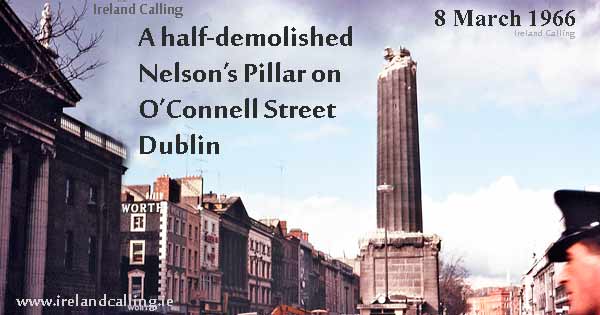On March 8th 1966 at half past one in the morning an explosion rocked the city of Dublin… and blew away the most prominent symbol of British imperialism in Ireland. Nelson’s Pillar – honoring the British admiral who won the Battle of Trafalgar – had dominated the skyline on O’Connell Street for more than a hundred years.
Dubliners, many of whom still remembered Ireland’s hard won fight for independence, didn’t like a British aristocrat looking down on them. To add insult to injury, Nelson was also looking down on the GPO – the centre of the Easter Rising and symbol of Irish freedom. Matters came to a head as Ireland prepared for the Rising’s 50th anniversary. How could Ireland celebrate its newfound freedom while the 134ft Nelson’s Pillar remained standing, a towering reminder of its former servitude.
Matters came to a head as the anniversary of the Easter Rising approached. The pillar was destroyed by a bomb planted by a splinter group of the IRA. It was called ‘Operation Humpty Dumpty’ and its intention was to remove the most famous symbol of British rule in Ireland.
The explosion only partially destroyed the pillar. It blew off the top 64ft of it, leaving a jagged 70ft stump.
The Irish authorities safely destroyed what remained of the pillar in a ‘controlled’ explosion within a week.
The bombing took place in the middle of the night, and thankfully no-one was injured by the blast. The event took place before the Troubles in Northern Ireland and it is believed the attack on Nelson’s Pillar was simply a symbolic act to honour those who fought in the Easter Rising and to remove the British presence in Ireland.
There were even suggestions that the Irish government were privately thankful that the statue had been targeted as they didn’t want the tribute to a British leader in their capital but couldn’t find a diplomatic reason to justify removing it.
The destruction of Nelson’s Pillar was generally well received by the Irish public according to newspaper reports from the time.
The Irish Times reported: “Gaiety and joie-de-vivre prevailed throughout O’Connell Street.
“There were happy, smiling faces everywhere and witticisms like ‘poor old Nelson’ were greeted with roars of laughter.
“Even an American tourist who went around explaining everything to everyone was kindly received.”
Within a few days of the explosion a song called Up Went Nelson was recorded by The Go Lucky Four, a group of Belfast schoolteachers. The song went straight to the top of the Irish charts and stayed there for eight weeks.
Legendary folk band the Dubliners also recorded a single called Nelson’s Farewell.
There was never anyone charged for the bombing. However, in 2000 veteran Dublin republican Liam Sutcliffe claimed he was one of the men responsible.
He was interviewed by the Irish Times and said: “The first attempt was on the last day of February but the bomb didn’t go off.
“So I had to go up on March 1st and remove it. I went into Clerys, bought a nail clippers and stripped it. I had a week then to drop it back.
“I went back on March 7th, had electrics in a briefcase. I connected everything up and placed it in an aperture – one of the windows at the top – that looked up Henry Street.
“I shook the hand of the man up guarding the platform and said “Cheerio”. He went off after his shift that night and the bomb went off at 1.32 in the morning. I had it timed for 2am but I had it on fast and it gained 28 minutes.”
Sutcliffe was asked what he thought of the Spire that was erected in place of the Nelson Pillar. He said: “It looks like a great engineering job and a much better thing to have on the main street than an old foreign admiral with a broken arm and a missing leg.”
Sutcliffe was questioned by gardaí but was released without charge.
history.html
